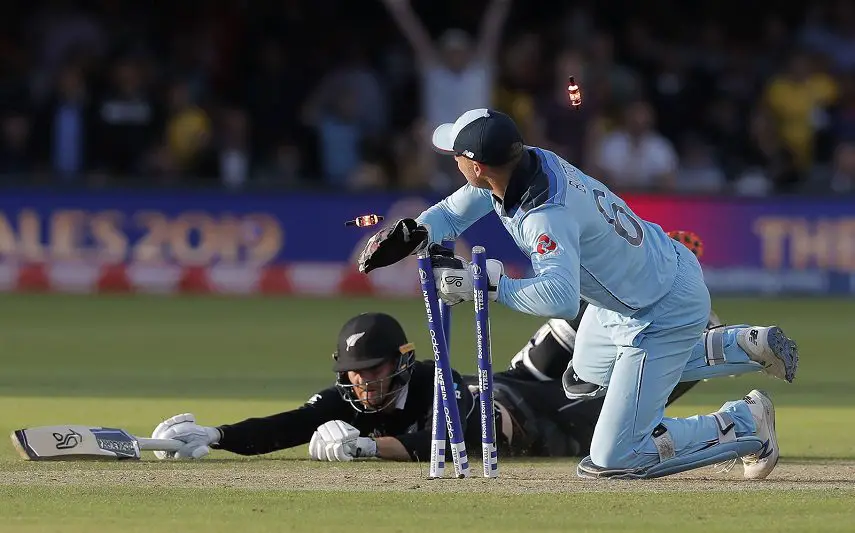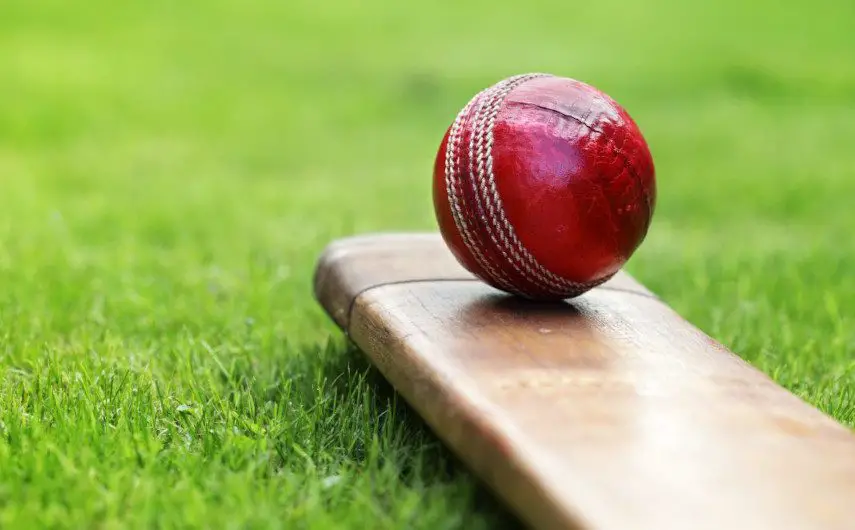Table of Contents
In order that the bowler doesn’t gain an unfair advantage, there are certain safeguards in place for the batsman. A no ball will be called and signalled if, in the umpire’s opinion, an illegal delivery has been sent down.
There are a number of ways in which a delivery can be called illegal and be declared a no ball. The most common of these relates to the front foot law.
What is a No Ball in Cricket?
A no ball is an illegal delivery provided by the bowler. Most methods of dismissal, including the most common three – bowled, LBW and caught – do not apply in the event of a no ball being called.
One run will be added to the batting side’s total and the delivery must be bowled again. A no ball can be called in a number of different circumstances. In addition, it is the umpire’s job to call and signal a free hit in relation to the next delivery, if he or she deems it appropriate. A free hit allows the batsman to strike the ball and, once again, he cannot be given out in most circumstances.
How Many No Balls are there in Cricket?
As of 2021, there are twelve main ways in which a no ball can be called by the umpire. Some of the types of no ball discussed below are traditional and have been part of the laws of cricket for centuries while others are relatively new.
The full list reads as follows:
Types of No Ball in Cricket
1. Front Foot No Ball
The most common type of illegal delivery is a front foot no ball. In order for a delivery to be considered legal, the bowler must have some part of their front foot behind the popping crease when the ball leaves their hand. If a bowler’s foot lands behind the line and subsequently slides over it then that’s OK as the no ball can only be called and signalled at the point in which the foot hits the ground.
It’s important to remember that the crease itself belongs to the umpire so, if the foot is on the line then it’s a no ball. The delivery is only considered to be fair if there is a part of the foot behind the popping crease.
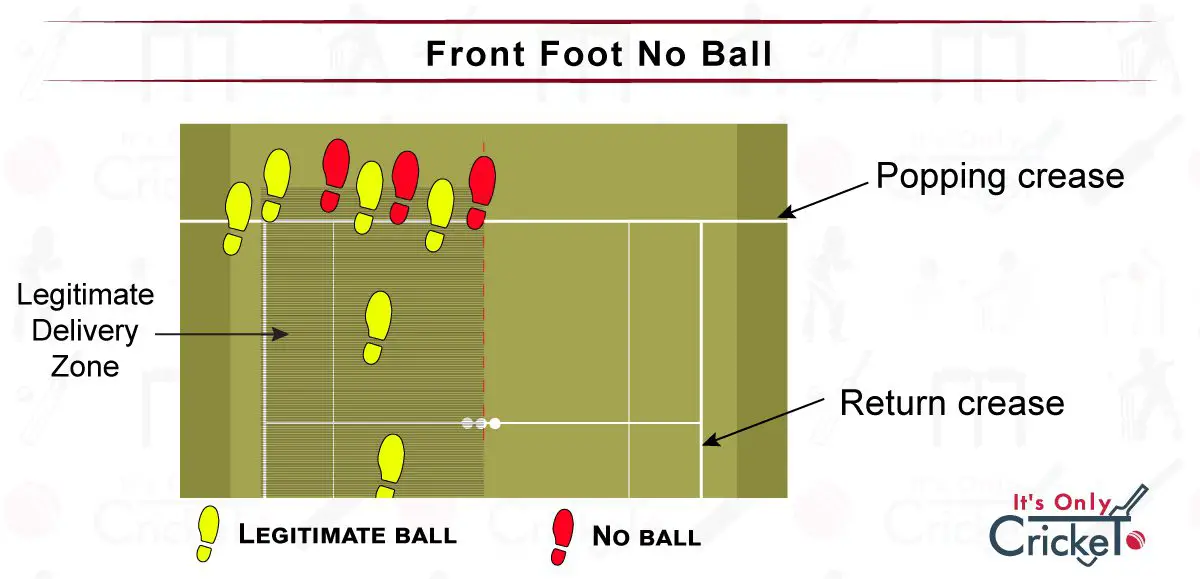
In case of front foot no balls, one run is added to the batting side’s total and the bowler must bowl the ball again. Additionally, if the game is a One Day or T20 match, the next ball is a free hit.
When a ball is delivered front foot, the only means by which a batsman can be out is via the following methods: Hit the Ball Twice, Run Out or Obstructing the Field.
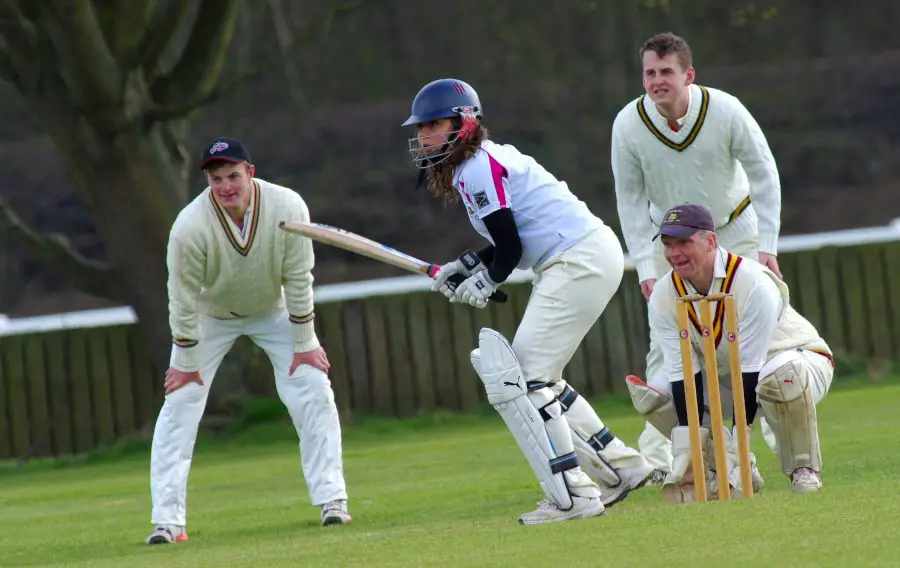
2. No Ball for Bowler Touching the Return Crease
The return crease is represented by the two vertical lines to the side of the stumps at either end. When delivering the ball, the bowler must stay within the confines of these lines and if he were to break them with either foot, the standing umpire shall call and signal no ball.
Unlike the front foot no ball, both feet must be entirely within that return crease at the point of delivery. If either foot touches the line, a no ball should be called. A run will be added to the batting team’s total and the bowler must send down the delivery again. In addition, a free hit will be called in One Day or T20 cricket.
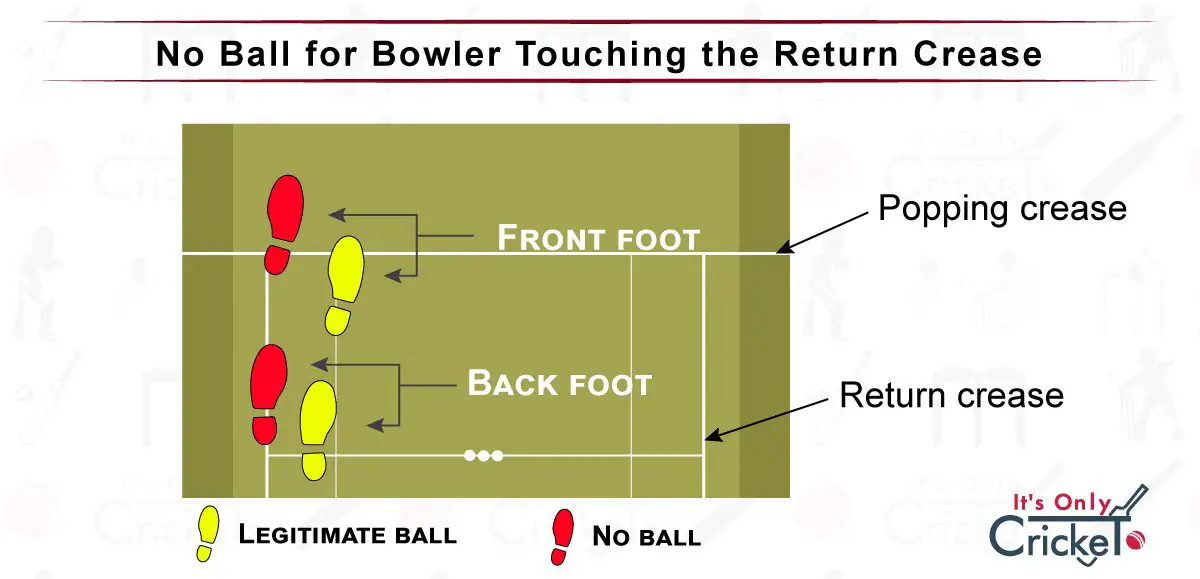
3. No Ball Called Based on Height (Full Toss)
Cricket is working hard to eliminate dangerous play and, as such, a no ball can now be called if a full toss is delivered above waist height. To be called as a no ball, the delivery must be deemed to be above waist height at the point that it would reach the batsman in their normal stance.
If it is determined that a no ball has been sent down, one run will be added to the batting total and the bowler must bowl it again. A free hit must be declared in one day cricket and the batsmen can only be given out by those three methods – run out, hit the ball twice or obstructing the field.
There is another point to note for umpires here: If the delivery is accidental then the bowler should be cautioned. If the same bowler bowls another no ball in this fashion, they should then be taken out of the attack. If, however, the initial no ball is deemed to be deliberate, they should be removed from the attack without warning.
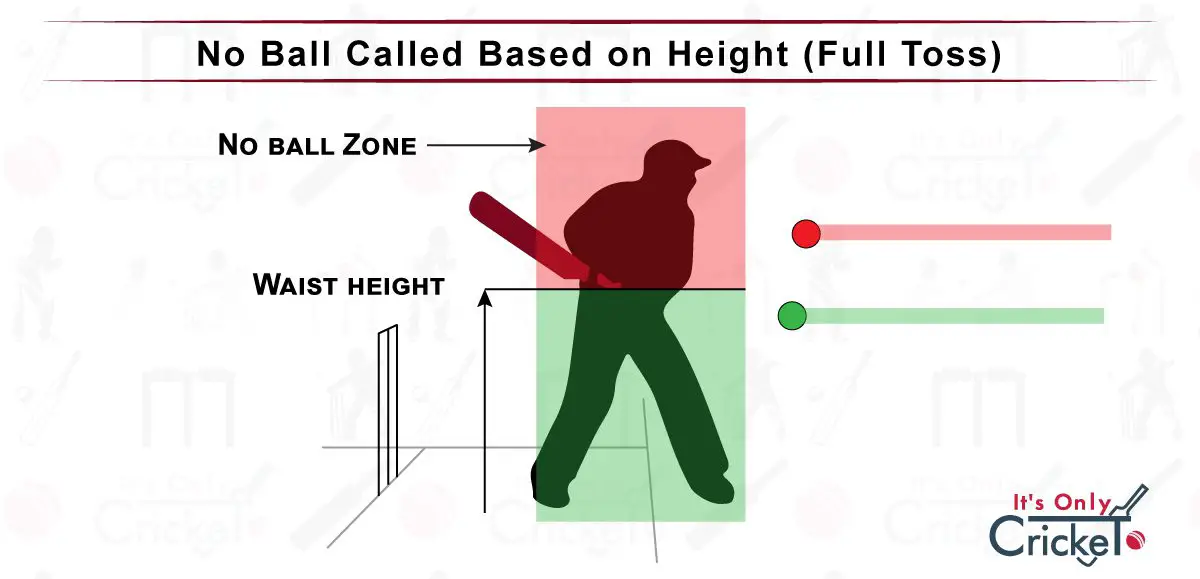
4. No Ball for the Ball Bouncing Over Head Height
Height is also an issue in our next type of no ball but, in this instance, the delivery is able to bounce. If, after the ball has bounced, it travels over the batsman at above head height, a no ball should be called.
To be deemed an illegal delivery in this way, the square leg umpire shall determine that the ball is higher than the batsman’s head if he were upright.
The usual supplementary laws to this type of no ball will apply so there will be an extra run given to the batting side. The possibilities for dismissal are limited and the next delivery will be a free hit in one day cricket.
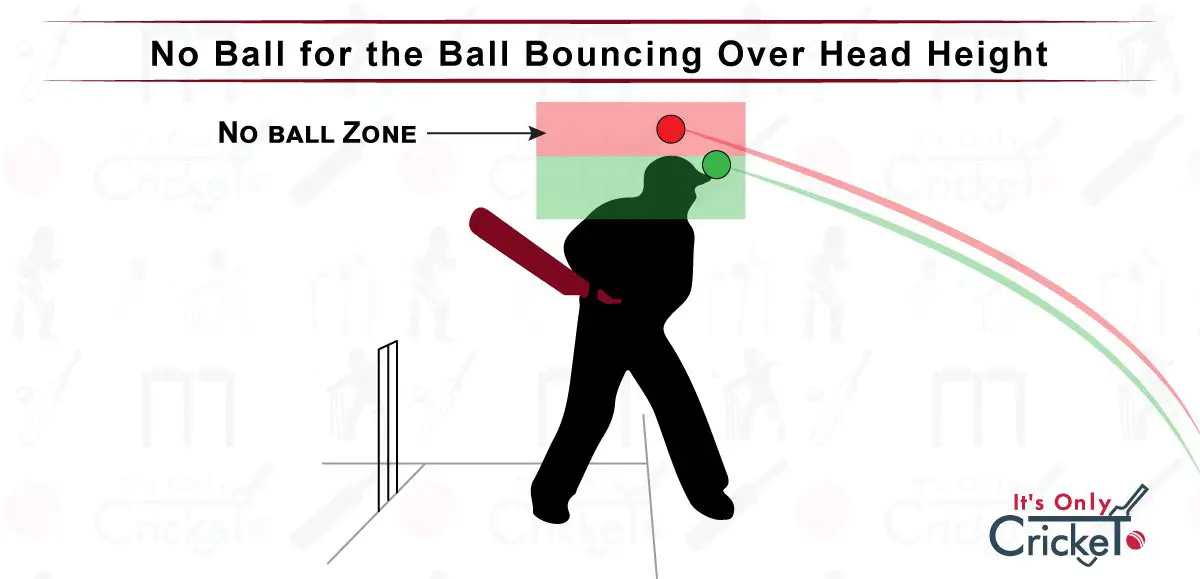
5. No Ball for the Ball Bouncing Multiple Times or Pitching Off the Strip
Recent changes to the Laws of cricket have introduced a separate set of circumstances where a no ball can be called and signalled. In cricket, a delivery is only allowed to bounce once before it reaches the batsman. If the ball bounces two or more times, the standing umpire shall call and signal no ball.
In addition, it is also a no ball if the ball rolls along the ground after delivery.
Separately, and distinct from a ‘wide ball’, a no ball is called if the ball pitches outside of the cut strip that has been prepared for play. The batsman, while standing in his regular stance, would have no chance of hitting the ball and this would be declared an unfair delivery.
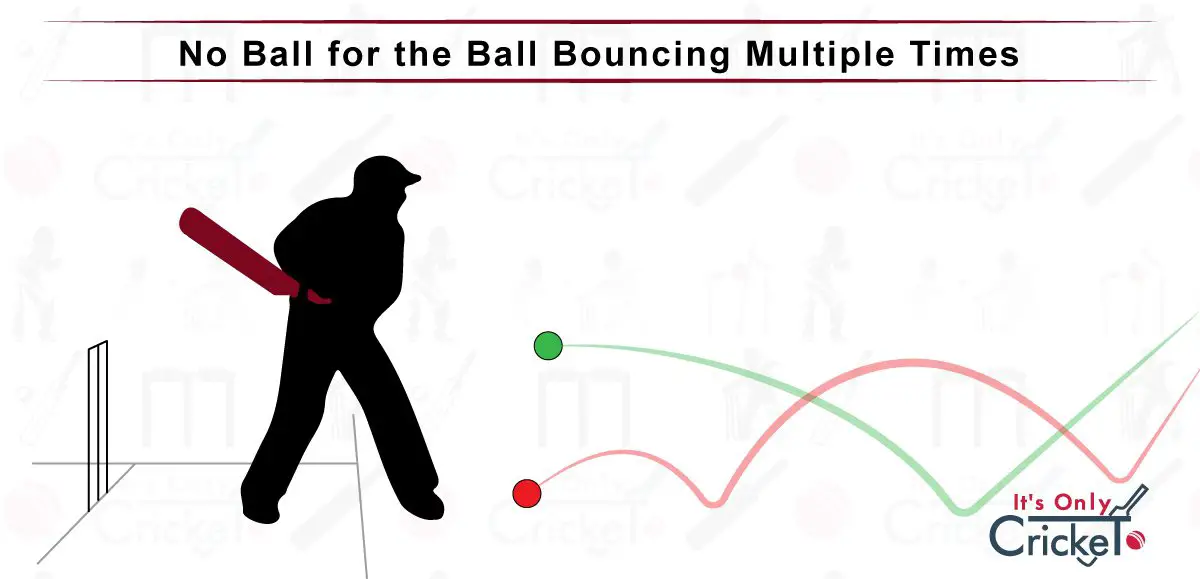
6. No Ball if Bowler Breaks the Wicket In Delivery
This is a relatively new addition to the list of no balls and it underlines how cricket’s laws have evolved over the years. For the bowler breaking the wicket at his own end after the ball comes into play and before he completes the delivery stride, the umpire shall call and signal no ball.
This law was introduced after England’s Steven Finn had issues with breaking the wicket. South African captain Graeme Smith argued that this was distracting to the batsman and it was agreed that this should be classed as an illegal delivery.
This no ball rule doesn’t apply to ‘Mankading’ where the bowler runs out the non striking batsman who has left his or her crease. I’ll cover this in more detail but this doesn’t count as a no ball as the bowler would have stopped in their delivery before completing the run out.
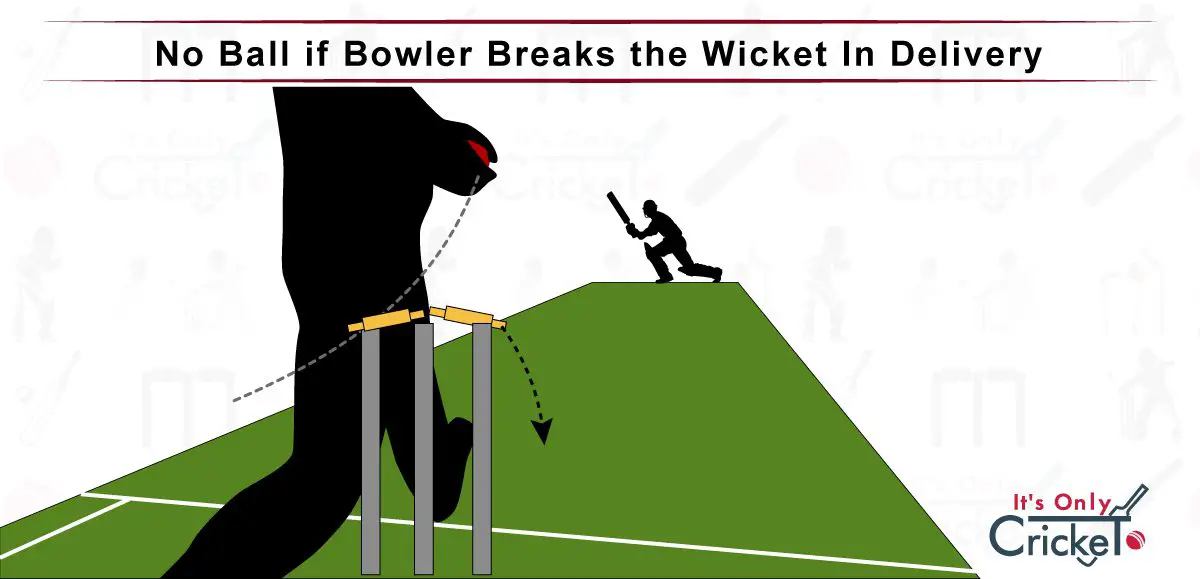
7. No Ball for Throwing the Ball
At the point of delivery, the bowler’s arm must be straight: There is a small degree of flexibility and this can be contentious at times but, if the square leg umpire feels that the bowler throws the ball, as opposed to bowling it, then they shall call and signal no ball.
That level of flexibility is up to 15 degrees in the elbow joint which is extremely difficult to call in a live match. The umpire must, therefore, be completely certain that the bowler has gone beyond this point. If a bowler infringes in this way twice in a match, the fielding team’s captain should be consulted and the bowler would be removed from the attack for the rest of the innings.
8. No Ball for Underarm Bowling
In ancient games of cricket, it was more prevalent for the ball to be delivered with underarm bowling but these days the practise is outlawed. This is another relatively new law that has been brought in to ensure fair play following an infamous incident in a one day international between Australia and New Zealand. With New Zealand needing a six to win, Australia’s Trevor Chappell was ordered to bowl underarm so that the Kiwis couldn’t clear the boundary.
In the modern day, if a bowler delivers underarm, the umpire shall call and signal no ball, and it doesn’t matter how many times the ball is bouncing before reaching the batsman.
9. No Ball for Failing to Declare a Correct Bowling Action
Before a bowler comes on to start his spell, the umpire will ask him or her for their intended mode of delivery. He or she will either be left or right handed and they will deliver from Around or Over the wicket. Having declared this information, the umpire will then convey it to the batsman.
If the bowler then delivers in a manner contrary to that which has been declared, the standing umpire shall call and signal no ball. The same principle applies if the bowler later changes their mode of delivery without first notifying the standing umpire.
10. No Ball for a Fielder Intercepting a Delivery
This has to be an exceptionally rare form of no ball and it would be tough for anyone to recall an instance where this has happened. However, if the bowler’s delivery has been intercepted by a fielder before it reaches the batsman, the umpire shall call and signal a no ball.
A no ball can also be called if a fielder encroaches on the pitch, even if they don’t come into contact with the ball. In addition, the wicket keeper must not take the ball in front of the stumps unless the batsman has struck it or it has hit the batsman’s body.
A fielder intercepting a delivery could very well be an accident in which case it would be more plausible but, in any instance where the wicket keeper or fielder makes that interception before the batsman has had a chance to play, the umpire shall call and signal no ball.
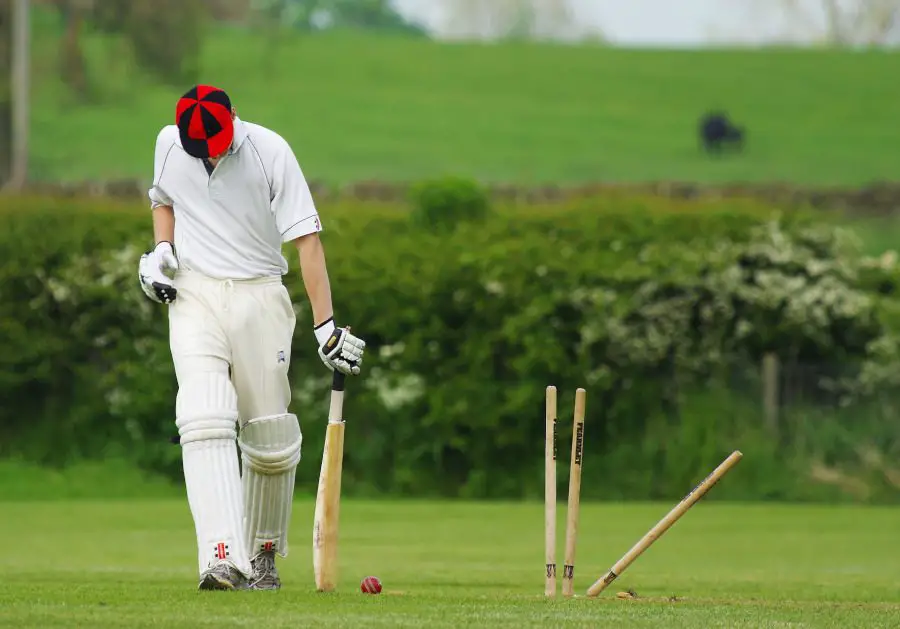
11. No Ball for Dangerous Bowling
Dangerous Bowling is a general term which can be applied by either umpire. Outside of the full tosses and above head high bouncers, this has its own category. It’s a little hard to clarify but it could be applied if, perhaps, a bowler is continually delivering head high bouncers to a tail ender.
Short pitched deliveries are part of a fast bowler’s armoury but they can be dangerous, especially when they are sent down to one of the weaker, tail-end batters. A short pitched ball doesn’t have to be classed as a bouncer but, if the bowler continually appears to aim at the body in an attempt to intimidate rather than dismiss the batter, the umpires can call a no ball.
As a statement that covers all of the points in this section, a no ball can be called if the ‘umpire deems the bowler to be bowling dangerously and unfairly.’
Essentially, while it’s a slightly obscure law, it’s in place at the umpires’ discretion and can be used to ensure safe and fair play.
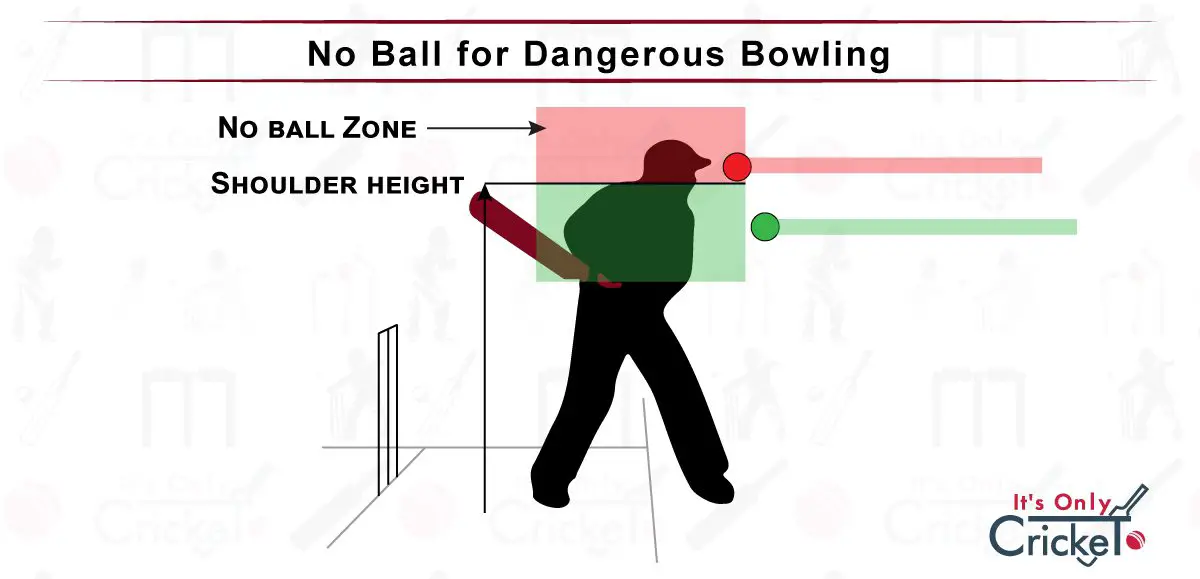
12. Leg Side No Ball
A leg side no ball is an extremely rare event and it happens through no fault of the bowler. As the ball is delivered by the bowler, a no ball will be called if there are more than two fielders behind square leg on the on side.
The law was introduced following the infamous Ashes Bodyline series in the 1930s. Facing a strong Australian side, the English tourists packed the leg side with fielders and delivered what was widely considered to be intimidatory bowling. As a result, no more than two on-side fielders can be behind square.
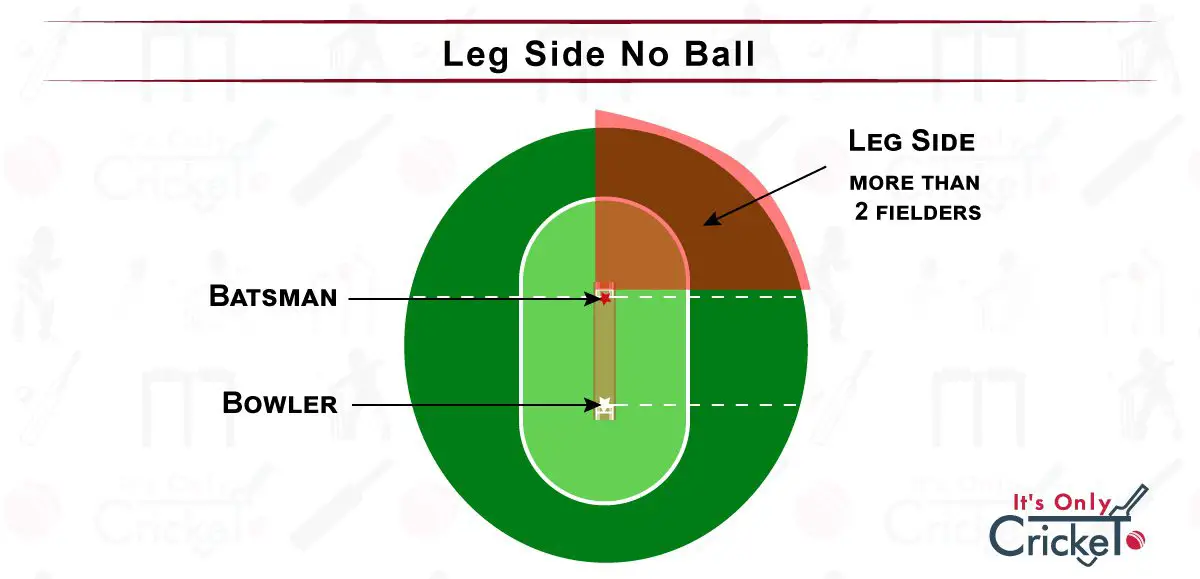
13. No Ball for Throwing the Ball Before Delivery
Along with the more common examples of no balls listed above, there are other possibilities. These are much rarer and will hardly ever be seen but they do constitute a no ball under the laws so they do need to be mentioned.
Under law 21.4, the umpires shall call and signal no ball if the bowler throws the ball towards the striker’s end before he or she delivers it. This could potentially happen and is an action that could be used to prevent the batters from stealing a run.
14. No Ball if Ball Stops Before Striker’s Wicket
If the bowler completes their delivery and the ball stops before reaching the striker’s wicket without it having been touched the bat or the batsman, the umpire shall call and signal no ball.
Once again, this is rare but it could happen if the ball slips out of the bowler’s hand.
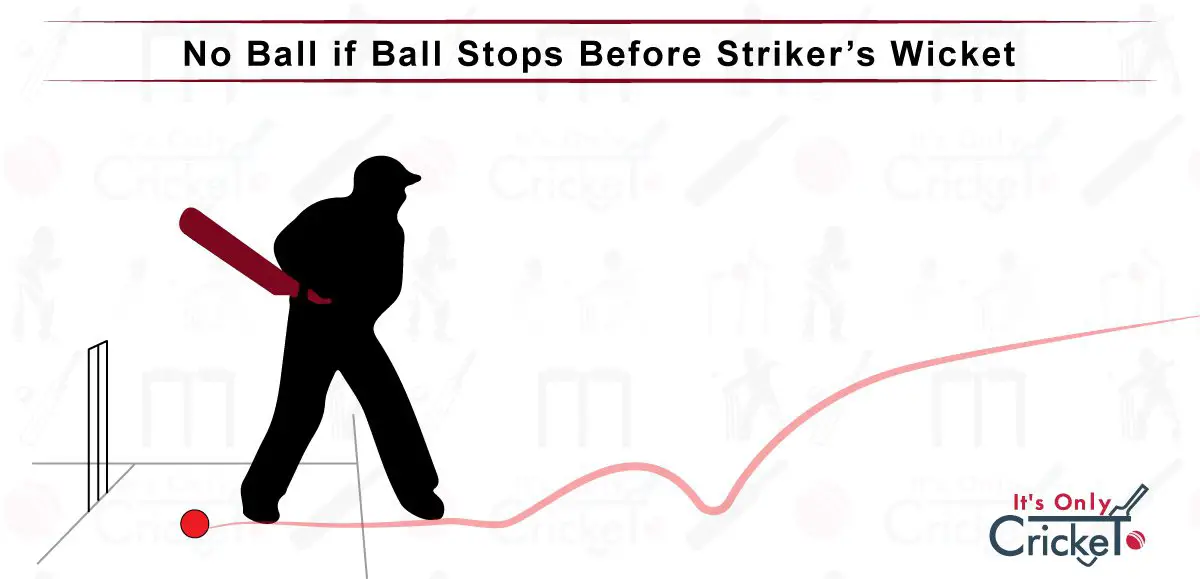
15. Back Foot No Ball
A back foot no ball should be called and signalled if the bowler’s back foot breaks the return crease on delivery.
Bowlers can often go wide of the stumps but that front foot must stay within the return crease.
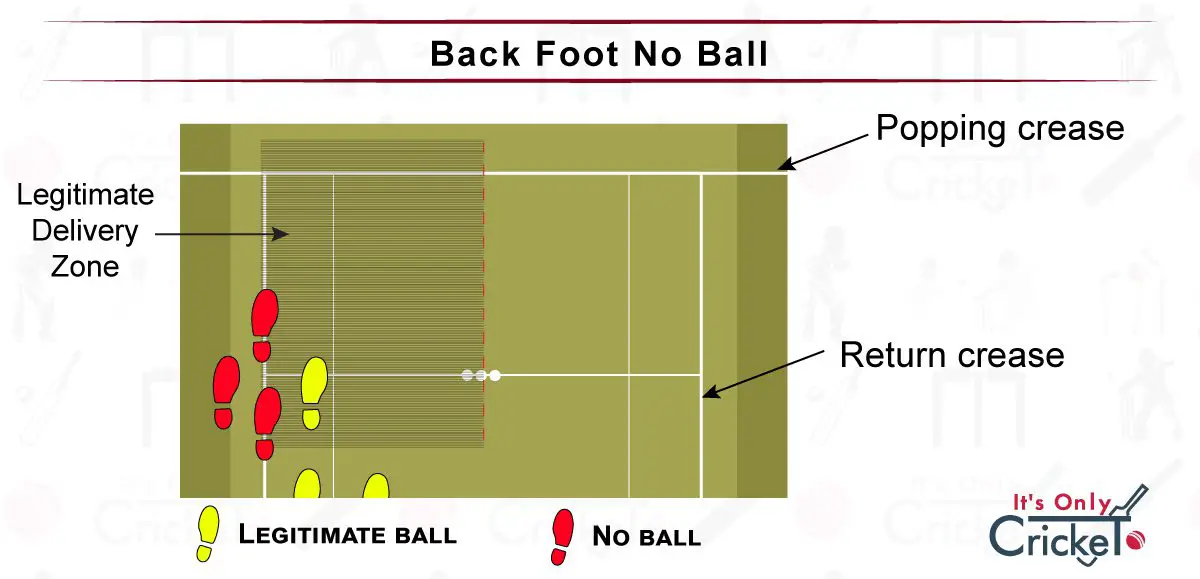
16. No Ball if Wicket Keeper is In Front of Stumps
Irrespective of whether the bowler has sent down a legitimate delivery or not, the wicket keeper must not take the ball in front of the stumps, unless the ball has hit the bat of any part of the batsman’s clothing or body.
If the ball is taken in front of the stumps with no batter intervention, the square leg umpire should call no ball.
No Ball FAQ
Can you be Stumped Off a No Ball?
A batsman cannot be given out stumped off a no ball. It’s considered to be an unfair delivery and, as the bowler gets credit for a stumping, these are not allowed if a no ball has been sent down.
This is slightly at odds with the fact that you can be stumped off a wide but the law is very clear in each case.
Can you be Run Out Off a No Ball?
A batsman can be run out off a no ball. With these types of dismissals, it’s a team effort and no credit is given to the bowler so this is completely admissible.
It’s also common sense as, in theory, batsmen could just keep running on a no ball without fear of being dismissed.
Are there any Bowlers who Never Bowled a No Ball?
There is some debate about this with a popular article in place suggesting that Ian Botham, Kapil Dev, Dennis Lillee, Lance Gibbs and Imran Khan never bowled a no ball.
However this simply isn’t true and each of those five delivered at least one no ball. What we so know is that Graeme Swann holds the record for most test deliveries without a no ball at over 15,000.

